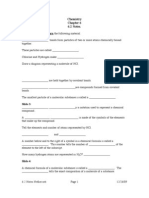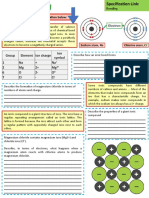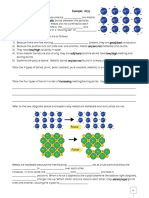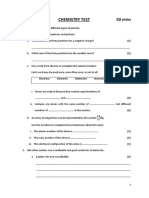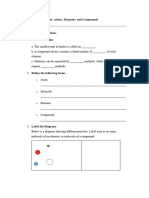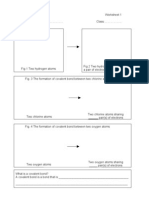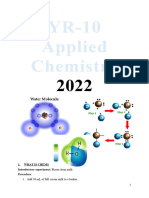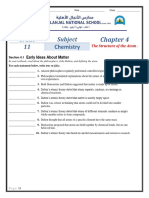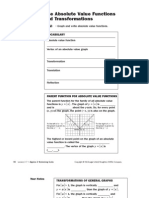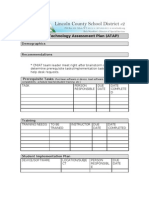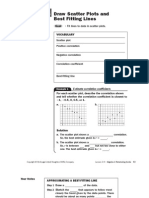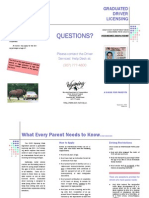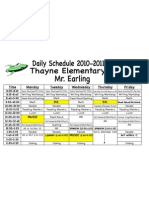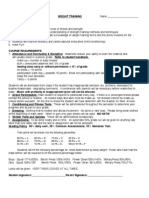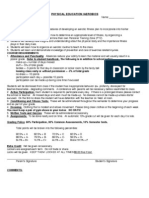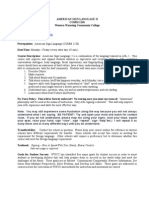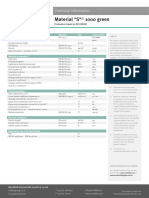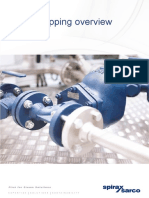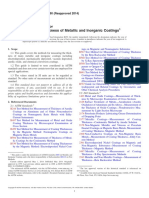Chemistry Chapter 6 6.3 Power Point Notes
Chemistry Chapter 6 6.3 Power Point Notes
Uploaded by
anon-579447Copyright:
Available Formats
Chemistry Chapter 6 6.3 Power Point Notes
Chemistry Chapter 6 6.3 Power Point Notes
Uploaded by
anon-579447Copyright
Available Formats
Share this document
Did you find this document useful?
Is this content inappropriate?
Copyright:
Available Formats
Chemistry Chapter 6 6.3 Power Point Notes
Chemistry Chapter 6 6.3 Power Point Notes
Uploaded by
anon-579447Copyright:
Available Formats
Chemistry
Chapter 6
6.3 Power Point Notes
Fill in the blanks from the power point presented in class.
Slide 2
Earth’s crust is made of _____________________. _________________________ are
made of minerals. Minerals, for the most part are _________________________
compounds. With ionic bonds, atoms are held together with _____________________
bonds. Ionic bonds are made with alternating _________________________ and
_________________________ ions.
Slide 3
Ionic substances are not made of ________________________ that can be pulled out and
exist on their own. There are no ________________________ in an ionic substance.
Water is a ________________________ (held together with covalent bonds) substance.
It contains individual particles (molecules) that are capable of stable
________________________. If we could magnify a drop of water we would see that it
is made of individual “pieces” of water called ________________________. We could,
theoretically, reach in, grab, and pull out a single piece of ________________________
(a molecule).
Make a drawing of a water molecule in the space below.
Slide 4
However, with ________________________ substances, this is not the case. We can’t
reach in and pull out a single ________________________of the compound that exists
independently. ________________________ Do not exist in an ionic substance,but
individual ions do exist. Salt, sodium chloride, is an example of an ionic compound. It is
made of individual ________________________ ions. Individual Cl- or Na+ ions could
be removed one at time, but NOT a ________________________ (molecule) of NaCl.
There is no such thing as a molecule of NaCl.
Slide 5
The simplest arrangement of ions that, when repeated trillions of times, would make a
crystal of an ionic substance is called a _______________________. From the unit cell
we can obtain the simplest collection of ions that would represent this compound’s
formula. We call this simplest ratio of ions an _______________________. What is the
empirical formula of Sodium chloride? _______________________ Chemical formulas
for ionic compounds are always _______________________
Draw and label the unit cell of sodium chloride.
Slide 6.
______________________________________________are made from elements that are
electron givers (metals) and electron takers (nonmetals).
Use several sentences to explain how an ionic bond forms.
Make a drawing of how an ionic bond forms.
Slide 7
Draw the ionic electron dot formula of sodium bromide.
What is the empirical formula of sodium bromide?
Slide 8
Draw the ionic electron dot formula of magnesium fluoride.
What is the empirical formula of magnesium fluoride?
Slide 9
Draw the ionic electron dot formula and empirical formula for aluminum iodide.
Slide 10
A ________________________________ is a molecule (group of atoms)
with a charge.
Draw the electron dot formula for ammonium. (NH41+)
Draw the electron dot formula for sulfate. (SO42-).
Slide 11
List Nine Common Polyatomic Ions. Know their Names, forumulas and charges. This is
a list you MEMORIZE. (and NEVER forget it).
Name of Ion Formula Charge
You might also like
- Chemistry Notes All Word 2016Document31 pagesChemistry Notes All Word 2016Bhuwneesh KumarNo ratings yet
- Chapter 6 Periodic Table Form 1Document12 pagesChapter 6 Periodic Table Form 1nantheni1779% (14)
- Physical Science Unit 3 Guided NotesDocument11 pagesPhysical Science Unit 3 Guided NotesflyingmsNo ratings yet
- Ionic Covalent Bonding Web QuestDocument5 pagesIonic Covalent Bonding Web QuestFiona IsbellNo ratings yet
- Chemistry Chapter 6 6.2 Notes.Document7 pagesChemistry Chapter 6 6.2 Notes.anon-579447No ratings yet
- Chapter 5Document8 pagesChapter 5Chin Fout LengNo ratings yet
- Ionic Bonding Practice QuestionDocument1 pageIonic Bonding Practice QuestionZhering RodulfoNo ratings yet
- Intro To Covalent BondingDocument5 pagesIntro To Covalent BondingDustin MoenchNo ratings yet
- Chemical Bonding KSSMDocument39 pagesChemical Bonding KSSMjayaselan100% (1)
- WebQuest - Ionic and Covalent BondingDocument5 pagesWebQuest - Ionic and Covalent Bondingashleyarrington02No ratings yet
- Chemical Bonding - ActivtyDocument9 pagesChemical Bonding - Activtyjosolrodel23No ratings yet
- Chemical Bonding KSSMDocument40 pagesChemical Bonding KSSMjayaselanNo ratings yet
- Covalent Bonding Lewis Structure WebquestDocument16 pagesCovalent Bonding Lewis Structure WebquestDean JezerNo ratings yet
- IonicBonds Student Exploration - GizmoDocument6 pagesIonicBonds Student Exploration - GizmoAshton DavenportNo ratings yet
- Metallic BondingDocument2 pagesMetallic BondingJohanna LipioNo ratings yet
- REV - Periodic Table, Ionic, Covalent BondingDocument6 pagesREV - Periodic Table, Ionic, Covalent Bondingtyler.nederpelt1No ratings yet
- Chemistry Test 50 MinsDocument7 pagesChemistry Test 50 MinsArman MoinNo ratings yet
- Practice Worksheet Grade X 2023Document10 pagesPractice Worksheet Grade X 2023Muhammad ShafayNo ratings yet
- Notes - Unit 2 Notes PacketDocument13 pagesNotes - Unit 2 Notes Packet2rzdkqqth5No ratings yet
- 10th OBJECTIVE 2022 CHEMISTRYDocument20 pages10th OBJECTIVE 2022 CHEMISTRYVarenayam editzNo ratings yet
- Bohr Diagrams, Valence Electrons, Lewis Dot StructuresDocument4 pagesBohr Diagrams, Valence Electrons, Lewis Dot StructureschabriesNo ratings yet
- Chapter 8.1Document9 pagesChapter 8.1Emily ChangNo ratings yet
- CHEMICAL BONDING-workbokDocument9 pagesCHEMICAL BONDING-workbokJenny Rose BatalonNo ratings yet
- PKT Bonding2 Student NotesDocument40 pagesPKT Bonding2 Student NotesrajaijahNo ratings yet
- Chemistry Section 6.5 PowerPoint NotesDocument5 pagesChemistry Section 6.5 PowerPoint Notesanon-579447No ratings yet
- Activity Sheet 4 Atomic StructureDocument3 pagesActivity Sheet 4 Atomic Structurehvnhvn.vnNo ratings yet
- Ionic Bonds SEDocument8 pagesIonic Bonds SEsarah.alawadiNo ratings yet
- Assessment 3 Science VII ObjectiveDocument2 pagesAssessment 3 Science VII ObjectiveSidra UsmanNo ratings yet
- NameDocument8 pagesNameromeyer810% (6)
- Chapter 6 Physical Science Notes RevDocument4 pagesChapter 6 Physical Science Notes Revapi-30718309No ratings yet
- Study Guide Ionic Compounds and Metals Student Editable PDFDocument8 pagesStudy Guide Ionic Compounds and Metals Student Editable PDFNicolyNo ratings yet
- Worksheet Chapter 5Document9 pagesWorksheet Chapter 5Maktok Azi RahimNo ratings yet
- Yr 10 Applied Chem Booklet-2Document68 pagesYr 10 Applied Chem Booklet-2DNo ratings yet
- Atoms Pearson 9 NotesDocument1 pageAtoms Pearson 9 NotesKirsten HunterNo ratings yet
- Lesson 11Document7 pagesLesson 11api-426620800No ratings yet
- 8th. Bonding Notes BLANKDocument4 pages8th. Bonding Notes BLANKAmerys MaureraNo ratings yet
- Sci9 Unit3 WorksheetDocument6 pagesSci9 Unit3 Worksheet肆月No ratings yet
- Atoms: Name - Date - PeriodDocument2 pagesAtoms: Name - Date - PeriodApril HeNo ratings yet
- Chapter7_Assessment_Ionic_Compounds_and_MetalsDocument7 pagesChapter7_Assessment_Ionic_Compounds_and_Metalsخالد الغامديNo ratings yet
- Chapter 7. Chemical Bonding and Molecular Structure Introduction To Ionic and Covalent BondingDocument6 pagesChapter 7. Chemical Bonding and Molecular Structure Introduction To Ionic and Covalent BondingLOVINGANGEL123No ratings yet
- Chapter 3 Matter and Atomic StructureDocument4 pagesChapter 3 Matter and Atomic StructureMari LarryNo ratings yet
- Atoms, Molecules and IonsDocument2 pagesAtoms, Molecules and Ionscydra.khaled1No ratings yet
- 2ND Partial ReviewDocument6 pages2ND Partial ReviewcarlosgabrielibarraalatorreNo ratings yet
- GG Atoms and Molecules Quiz - Rev2Document1 pageGG Atoms and Molecules Quiz - Rev2Reena ChengNo ratings yet
- Chapter 4 (Worksheet)Document7 pagesChapter 4 (Worksheet)Abdullah AlthaniNo ratings yet
- Physical Science Midterm Review GuideDocument6 pagesPhysical Science Midterm Review Guidekingpearl1000No ratings yet
- Notes and Questions: Aqa GcseDocument28 pagesNotes and Questions: Aqa Gcseapi-422428700No ratings yet
- C Yr09 MQF Lev1to3 2023Document12 pagesC Yr09 MQF Lev1to3 2023AdrianHedleyNo ratings yet
- Group28739 Id10543789Document5 pagesGroup28739 Id1054378975j5j758zqNo ratings yet
- C 13&14 ReDocument3 pagesC 13&14 RejbrameNo ratings yet
- Autumn 2 Y8 Pathway XDocument47 pagesAutumn 2 Y8 Pathway XH ChowdreyNo ratings yet
- Biochemistry Homework EditDocument18 pagesBiochemistry Homework Editterris jamesNo ratings yet
- Chapter5 Atoms Elements CompundsDocument14 pagesChapter5 Atoms Elements CompundsUdomporn TupbuchaNo ratings yet
- Physical Science Unit 2 Guided NotesDocument9 pagesPhysical Science Unit 2 Guided NotesflyingmsNo ratings yet
- Unit 2: Biochemistry Guided Notes Student VersionDocument12 pagesUnit 2: Biochemistry Guided Notes Student VersionRahsaan BurksNo ratings yet
- Ch21ChemistryofLifeGuidedReadingWSMillerLevine2019Biology-1 (1)Document4 pagesCh21ChemistryofLifeGuidedReadingWSMillerLevine2019Biology-1 (1)aslam.sanaaNo ratings yet
- Chem 12123123Document4 pagesChem 12123123ZombieSlayer1730No ratings yet
- Past Paper Micro World I II 2019 20 PDFDocument19 pagesPast Paper Micro World I II 2019 20 PDF779720 cNo ratings yet
- Chemistry Fill in The Blanks 2nd YearDocument22 pagesChemistry Fill in The Blanks 2nd YearAdnan KhanNo ratings yet
- UntitledDocument1 pageUntitledanon-579447No ratings yet
- 5SE AND:, Esson #OpyrightDocument5 pages5SE AND:, Esson #Opyrightanon-579447No ratings yet
- 5SE 3trategies: %xampleDocument3 pages5SE 3trategies: %xampleanon-579447No ratings yet
- Assistive Technology Assessment Plan (ATAP) : DemographicsDocument5 pagesAssistive Technology Assessment Plan (ATAP) : Demographicsanon-579447No ratings yet
- 3olve: 'RaphDocument4 pages3olve: 'Raphanon-579447No ratings yet
- Chapter 6 Worksheet Section 1 & 2 Section 1Document2 pagesChapter 6 Worksheet Section 1 & 2 Section 1anon-579447No ratings yet
- 'Oal 6/#!"5,!29 3lope 9our: %xampleDocument3 pages'Oal 6/#!"5,!29 3lope 9our: %xampleanon-579447No ratings yet
- 'Raph 4WO: #HeckingDocument3 pages'Raph 4WO: #Heckinganon-579447No ratings yet
- $raw "Est: %stimateDocument3 pages$raw "Est: %stimateanon-579447No ratings yet
- 'Raph: 'Oal Standard 6/#!"5,!29 0arent 9ourDocument4 pages'Raph: 'Oal Standard 6/#!"5,!29 0arent 9ouranon-579447No ratings yet
- Questions?: Graduated Driver LicensingDocument2 pagesQuestions?: Graduated Driver Licensinganon-579447No ratings yet
- Time Monday Tuesday Wednesday Thursday Friday: P.E. P.EDocument1 pageTime Monday Tuesday Wednesday Thursday Friday: P.E. P.Eanon-579447No ratings yet
- 14-20 Year Old DriversDocument11 pages14-20 Year Old Driversanon-579447No ratings yet
- Curriculum For Aerobics Units To Be CoveredDocument1 pageCurriculum For Aerobics Units To Be Coveredanon-579447No ratings yet
- The Civil WarDocument2 pagesThe Civil Waranon-579447No ratings yet
- Driving Log: Drivers Education Practice ChecklistDocument1 pageDriving Log: Drivers Education Practice Checklistanon-579447No ratings yet
- UntitledDocument2 pagesUntitledanon-579447No ratings yet
- Lacrosse Study Guide: About The GameDocument2 pagesLacrosse Study Guide: About The Gameanon-579447No ratings yet
- Rubric For Sport Skills: PointsDocument1 pageRubric For Sport Skills: Pointsanon-579447No ratings yet
- Soccer Rules - IntroductionDocument6 pagesSoccer Rules - Introductionanon-579447No ratings yet
- Beginning Keyboarding Numbers LessonDocument1 pageBeginning Keyboarding Numbers Lessonanon-579447No ratings yet
- Wyoming Motorcycle Laws RoadDocument2 pagesWyoming Motorcycle Laws Roadanon-579447No ratings yet
- Weight Training Final ProjectDocument1 pageWeight Training Final Projectanon-579447No ratings yet
- Physical Education /aerobicsDocument1 pagePhysical Education /aerobicsanon-579447No ratings yet
- Team Frisbee Games: UltimateDocument3 pagesTeam Frisbee Games: Ultimateanon-579447No ratings yet
- Internet Usage Is RequiredDocument3 pagesInternet Usage Is Requiredanon-579447No ratings yet
- Internet Use Is Required For PracticeDocument2 pagesInternet Use Is Required For Practiceanon-579447No ratings yet
- Informal GeometryDocument3 pagesInformal Geometryanon-579447No ratings yet
- Svhs Course SyllabusDocument4 pagesSvhs Course Syllabusanon-579447No ratings yet
- Supply List: 1 Box of 8 Regular Crayons (Red, Yellow, Blue, Green, Purple, Orange, Black, and Brown)Document1 pageSupply List: 1 Box of 8 Regular Crayons (Red, Yellow, Blue, Green, Purple, Orange, Black, and Brown)anon-579447No ratings yet
- Base Plate For Tensile LoadsDocument96 pagesBase Plate For Tensile Loadsfaizan ashiqueNo ratings yet
- Metallic MicrolatticeDocument3 pagesMetallic MicrolatticeAnonymous AMvlXRW3TsNo ratings yet
- MS C A Roofed Skeleton BOQDocument2 pagesMS C A Roofed Skeleton BOQBrighton MUZAHURANo ratings yet
- DSF SFF FsDocument2 pagesDSF SFF Fsaa999666aaaNo ratings yet
- IPTI 1036 Unit 1 Notes 2023Document33 pagesIPTI 1036 Unit 1 Notes 2023santiago ValleNo ratings yet
- ASTM C33. Standard Specification For Concrete AggregateDocument11 pagesASTM C33. Standard Specification For Concrete AggregateENGYA2007100% (1)
- Wood Ash 7Document4 pagesWood Ash 7r;rNo ratings yet
- End User: Kementerian Pendidikan Malaysia: NO Category Items Specifications BrandDocument50 pagesEnd User: Kementerian Pendidikan Malaysia: NO Category Items Specifications BrandwarieNo ratings yet
- RRLDocument2 pagesRRLDorothy Ailean GuerreroNo ratings yet
- Supply Schedule 2Document13 pagesSupply Schedule 2Grace PeterNo ratings yet
- Formwork Project (Fares Habib Shihab)Document16 pagesFormwork Project (Fares Habib Shihab)Fares XRNo ratings yet
- Contact List QatarDocument103 pagesContact List QatarAtif Syed86% (7)
- KAS Aluminium Specification Grade A7e and A8Document1 pageKAS Aluminium Specification Grade A7e and A8ikebane5595No ratings yet
- Avoiding High Temperature Hydrogen AttackDocument2 pagesAvoiding High Temperature Hydrogen AttackBrian Ahmad100% (1)
- Nanofiltration of Textile Plant Effluent For Color Removal and Reduction in CODDocument11 pagesNanofiltration of Textile Plant Effluent For Color Removal and Reduction in CODOmaya TariqNo ratings yet
- Storage Tanks Within Uplb Campus: Buan, Aina Angeline R. 2011-48777 Che 192 UDocument4 pagesStorage Tanks Within Uplb Campus: Buan, Aina Angeline R. 2011-48777 Che 192 UAngeline Reyes BuanNo ratings yet
- Bowl Cleaner Extra Flash MSDS 2Document1 pageBowl Cleaner Extra Flash MSDS 2SPG MAN MAGNo ratings yet
- Non-Ferrous& AssignmentDocument9 pagesNon-Ferrous& AssignmentOwen LunaticNo ratings yet
- Crusher Wear Parts Selection Guide: Jaws, Cones & ImpactorsDocument14 pagesCrusher Wear Parts Selection Guide: Jaws, Cones & Impactorsgildemeister gerencia100% (3)
- Bluewat-MSDS-Water de Colorant Agent-EnglishDocument4 pagesBluewat-MSDS-Water de Colorant Agent-EnglishMd. Monirul IslamNo ratings yet
- Saso 87Document8 pagesSaso 87Ayman EwaisNo ratings yet
- Whmis Symbols Information SheetDocument1 pageWhmis Symbols Information SheetDamian DuffNo ratings yet
- KOT12.SM - Operation Instruction of ASU - 2014.11.1Document41 pagesKOT12.SM - Operation Instruction of ASU - 2014.11.1sasanNo ratings yet
- Green Pin - Green Pin® Weld-On Transport RingDocument4 pagesGreen Pin - Green Pin® Weld-On Transport RingRadu StamatinNo ratings yet
- Murtfeldt Material S Group Material-S-1000-Green Technical Data enDocument1 pageMurtfeldt Material S Group Material-S-1000-Green Technical Data enPedro Henriques RamosNo ratings yet
- PLUMBINGDocument9 pagesPLUMBINGBryan Rudolph PascualNo ratings yet
- Spirax Trap Review GST - 33 PDFDocument22 pagesSpirax Trap Review GST - 33 PDFFrank UrsNo ratings yet
- AqueousDocument35 pagesAqueousDevananda R SNo ratings yet
- ASTM B659 90 Reapproved 2014 PDFDocument3 pagesASTM B659 90 Reapproved 2014 PDFFrancisco PerezNo ratings yet
- 17 Fondarex FSA ForumDocument43 pages17 Fondarex FSA ForumAditheya Varthan MNo ratings yet




